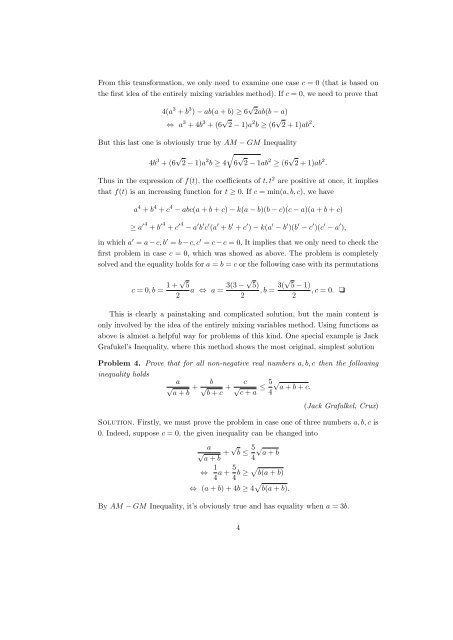The entirely mixing variables method
The entirely mixing variables method
The entirely mixing variables method
You also want an ePaper? Increase the reach of your titles
YUMPU automatically turns print PDFs into web optimized ePapers that Google loves.
From this transformation, we only need to examine one case c = 0 (that is based on<br />
the first idea of the <strong>entirely</strong> <strong>mixing</strong> <strong>variables</strong> <strong>method</strong>). If c = 0, we need to prove that<br />
4(a 3 + b 3 ) − ab(a + b) ≥ 6 √ 2ab(b − a)<br />
⇔ a 3 + 4b 3 + (6 √ 2 − 1)a 2 b ≥ (6 √ 2 + 1)ab 2 .<br />
But this last one is obviously true by AM − GM Inequality<br />
4b 3 + (6 √ √<br />
2 − 1)a 2 b ≥ 4 6 √ 2 − 1ab 2 ≥ (6 √ 2 + 1)ab 2 .<br />
Thus in the expression of f(t), the coefficients of t, t 2 are positive at once, it implies<br />
that f(t) is an increasing function for t ≥ 0. If c = min(a, b, c), we have<br />
a 4 + b 4 + c 4 − abc(a + b + c) − k(a − b)(b − c)(c − a)(a + b + c)<br />
≥ a ′ 4 + b<br />
′4 + c<br />
′4 − a ′ b ′ c ′ (a ′ + b ′ + c ′ ) − k(a ′ − b ′ )(b ′ − c ′ )(c ′ − a ′ ),<br />
in which a ′ = a − c, b ′ = b − c, c ′ = c − c = 0. It implies that we only need to check the<br />
first problem in case c = 0, which was showed as above. <strong>The</strong> problem is completely<br />
solved and the equality holds for a = b = c or the following case with its permutations<br />
c = 0, b = 1 + √ 5<br />
2<br />
a ⇔ a = 3(3 − √ 5)<br />
2<br />
, b = 3(√ 5 − 1)<br />
, c = 0. ❑<br />
2<br />
This is clearly a painstaking and complicated solution, but the main content is<br />
only involved by the idea of the <strong>entirely</strong> <strong>mixing</strong> <strong>variables</strong> <strong>method</strong>. Using functions as<br />
above is almost a helpful way for problems of this kind. One special example is Jack<br />
Grafukel’s Inequality, where this <strong>method</strong> shows the most original, simplest solution<br />
Problem 4. Prove that for all non-negative real numbers a, b, c then the following<br />
inequality holds<br />
a b c<br />
√ + √ + √ ≤ 5 a + b + c.<br />
a + b b + c c + a 4√<br />
(Jack Grafulkel, Crux)<br />
Solution. Firstly, we must prove the problem in case one of three numbers a, b, c is<br />
0. Indeed, suppose c = 0, the given inequality can be changed into<br />
a<br />
√<br />
a + b<br />
+ √ b ≤ 5 4√<br />
a + b<br />
⇔ 1 4 a + 5 4 b ≥ √ b(a + b)<br />
⇔ (a + b) + 4b ≥ 4 √ b(a + b).<br />
By AM − GM Inequality, it’s obviously true and has equality when a = 3b.<br />
4
















